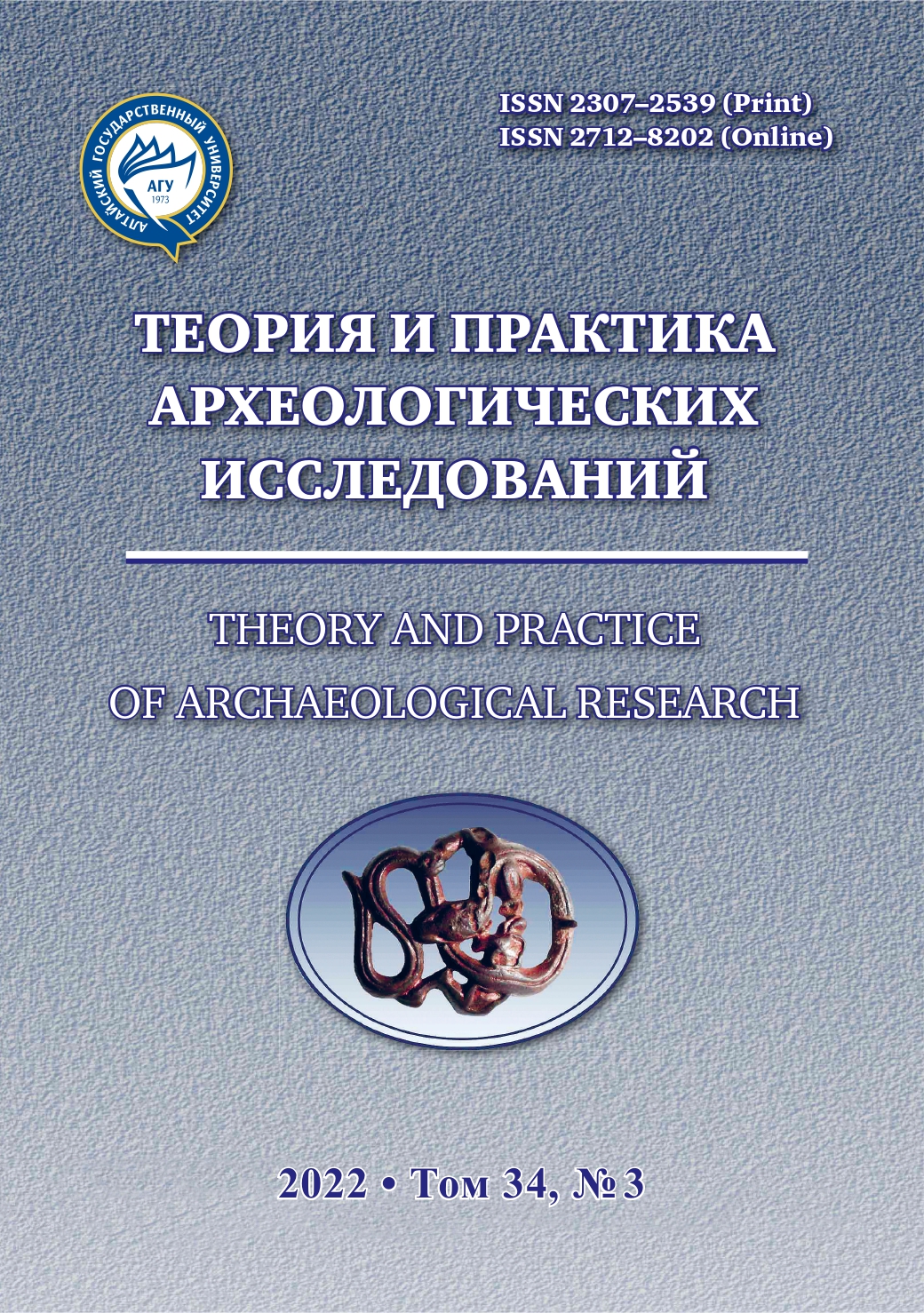PRELIMINARY RESULTS OF THE RESEARCH INTO THE SITES OF THE XIANBEI PERIOD IN THE KAZAKH ALTAI
Abstract
This article is devoted to the preliminary results of the study of the materials obtained during the excavations on the territory of the Kazakh Altai archaeological complex of the Xianbei period at the Berel burial ground. Aft er the fall of the Hunnic Empire, the nomadic association of Xianbei, known from Chinese written sources, had a huge infl uence on the appearance of the archaeological cultures of Altai. For the fi rst time in Altai, archaeological material concerning this polyethnic community was obtained in the last quarter of the last century. However, for a long time, archaeologists could not identify the Xianbei site from other numerous excavated archaeological sites. For the purpose of detailed cultural and chronological identifi cation, Chinese materials were used, which made it possible to bring the problem of identifying Xianbei sites to a qualitatively new level. On the territory of the Kazakh Altai, the period of intensive study of the Xianbei circle of sites began in 2015, when a series of new funeral and memorial structures was opened. These studies allowed not only expanding the boundaries of this community and, but also putting forward the thesis about the large-scale penetration of the Xianbei in the 3rd–4th centuries AD into the territory under consideration.
Downloads
Metrics
No metrics found.
References
Bichurin N. Ya. Collection of Information about the Peoples who Lived in Central Asia in Ancient times. Moscow; L. : Izd-vo AN SSSR, 1950. T. I. 382 p. (In Russ.)
Bobrov L. A., Khudyakov Yu. S. Military Aff airs of the Xianbei States of Northern China the 4th–6th Centuries AD. In: Warfare of the Nomads of Central Asia in the Xianbei Era. Novosibirsk: B.i., 2005. Pp. 80–199. (In Russ.)
Gavrilova A. A. Burial Ground Kudyrge as a Source on the History of the Altai Tribes. Moscow; Leningrad : Nauka, 1965. 145 p. (In Russ.)
Gorbunov V. V. Xianbei Armor. In: Warfare of the Nomads of Central Asia in the Xianbei era. Novosibirsk : B.i., 2005. Pp. 200–223. (In Russ.)
Dashkovsky P. K., Meikshan I.A. Religious landscape of Western Siberia and Adjacent Regions of Central Asia. Late Antiquity — the Beginning of the Twentieth Century. Barnaul : Izd-vo Alt. un-ta, 2014. Vol. 1. 214 p. (In Russ.)
Kitov E. P., Kitova A. O. Report on the Study of Bone Remains from the Berel Burial Ground Using the Methods of Physical Anthropology. In: Report on the Topic “Th e Sites of the Sakas and Xianbeis of the Kazakh Altai” for 2018. Archive GIKZM “Berel”, 2018. 276 p. (In Russ.)
Kryukov M. V., Perelomov L. S., Sofronov M. V., Cheboksarov N.N. The Ancient Chinese in the Era of Centralized Empires. Moscow : Nauka, 1983. 410 p. (In Russ.)
Kychanov E. I. History of Ancient and Medieval States Bordering China (from the Huns to the Manchus). 2nd ed. St. Petersburg : Peterburgskoe lingvisticheskoe obshhestvo, 2010. 364 p. (In Russ.)
Lubo-Lesnichenko E. I. Imported Mirrors from the Minusinsk Basin. On the Issue of External Relations of the Ancient Population of Southern Siberia. Series: Culture of the Peoples of the East. Moscow : Nauka, 1975. 170 p. (In Russ.)
Nikonorov V. P., Khudyakov Yu.S. “Whistling Arrows” by Maodun and “Mars Sword” by Attila: Warfare of Asian Xiongnu and European Huns. St. Petersburg : Peterburgskoe vostokovedenie, 2004. 320 p. (In Russ.)
Savinov D. G. The Peoples of Southern Siberia in the Ancient Turkic Era. Leningrad : Izdvo LGU, 1984. 174 p. (In Russ.)
Samashev Z. Berel. Almaty : Tajmas, 2011. 236 p. (In Russ.)
Samashev Z. Once Again about the Objects with Stone Ridges. Vestnik KazNU. Seriya istoricheskaya = KazNU Bulletin. Historical Series. 2021;102(3):81–92 (In Russ.)
Samashev Z., Kariev E.M., Erbolatov S.E. Xiongnu-Xianbei Cultural and Chronological Horizon of Berel. In: Margulan Readings-2019: Materials of the International Archaeological Scientifi c and Practical Conference Dedicated to the 95th Anniversary of the Birth of the Outstanding Kazakh Archaeologist K.A. Akisheva. Nur-Sultan : B.i., 2019. Pp. 385–393. (In Russ.)
Soenov V. I. The Results of Excavations at the Verkh-Uimon Burial Ground in 1999. In: Antiquities of Altai. Proceedings of the Laboratory of Archaeology of Gorno-Altaisk : GAGU, 2000. No. 5. Pp. 48–62. (In Russ.)
Soenov V. I. Finding of an Iron Broadsword in Altai // Preservation and Study of the Cultural Heritage of the Altai Territory. Barnaul : Izd-vo Alt. un-ta, 2017. Issue XXIII. Pp. 142–150. (In Russ.)
Tishkin A. A., Matrenin S. S., Schmidt A. V. Altai in the Syanbi-Zhuzhan Time (Based on the Materials of the Stepushka Site). Barnaul : Izd-vo Alt. un-ta, 2018. 368 p. (In Russ.)
Tishkin A. A., Seregin N. N. Metallic Mirrors as a Source on the Ancient and Medieval History of Altai (Based on the Materials of the Museum of Archaeology and Ethnography of Altai, Altai State University). Barnaul : Azbuka, 2011. 144 p. (In Russ.)
Tishkin A. A., Khavrin S. V. Th e Use of X-ray Fluorescence Analysis in Archaeological Research. In: Theory and Practice of Archaeological Research. Barnaul : Izd-vo Alt. un-ta, 2006. Issue 2. Pp. 74–86. (In Russ.)
Khudyakov Yu. S. Armament of the Central Asian Nomads in the the 2nd –5th centuries AD. In: Military Affairs of the Nomads of Central Asia in the Xianbei Era. Novosibirsk : B.i., 2005. Pp. 19–55. (In Russ.)
Khudyakov Yu. S., Yu Su-Hua. Th e Role of the Xianbei in the Development of the Weapons of the Nomads of Central Asia. In: Equipment of the Nomads of Eurasia. Barnaul : Izdvo Alt. un-ta, 2005. Pp. 55–59. (In Russ.)
Theory and Practice of Archaeological Research is a golden publisher, as we allow self-archiving, but most importantly we are fully transparent about your rights.
Authors may present and discuss their findings ahead of publication: at biological or scientific conferences, on preprint servers, in public databases, and in blogs, wikis, tweets, and other informal communication channels.
Theory and Practice of Archaeological Research allows authors to deposit manuscripts (currently under review or those for intended submission to ABS) in non-commercial, pre-print servers such as ArXiv.
Authors who publish with this journal agree to the following terms:
- Authors retain copyright and grant the journal right of first publication with the work simultaneously licensed under a Creative Commons Attribution License (CC BY 4.0) that allows others to share the work with an acknowledgement of the work's authorship and initial publication in this journal.
- Authors are able to enter into separate, additional contractual arrangements for the non-exclusive distribution of the journal's published version of the work (e.g., post it to an institutional repository or publish it in a book), with an acknowledgement of its initial publication in this journal.
- Authors are permitted and encouraged to post their work online (e.g., in institutional repositories or on their website) prior to and during the submission process, as it can lead to productive exchanges, as well as earlier and greater citation of published work (See The Effect of Open Access).








2.jpg)




